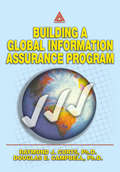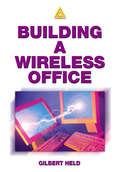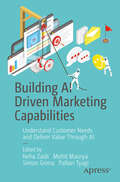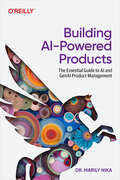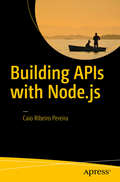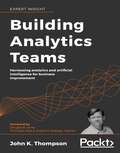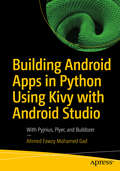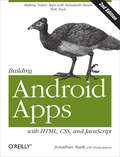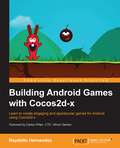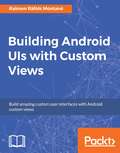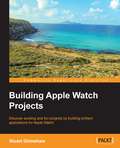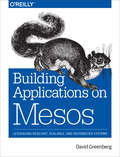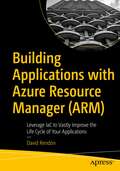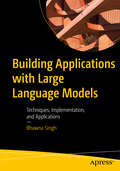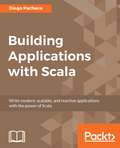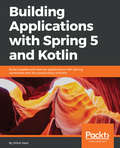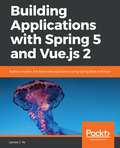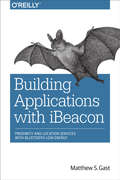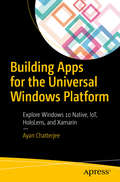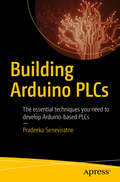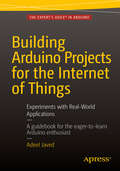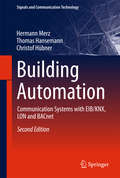- Table View
- List View
Building A Global Information Assurance Program
by Raymond J Curts Douglas E. CampbellGovernments, their agencies, and businesses are perpetually battling to protect valuable, classified, proprietary, or sensitive information but often find that the restrictions imposed upon them by information security policies and procedures have significant, negative impacts on their ability to function. These government and business entities are
Building A High-Performance Team
by Sarah CookIT managers' work cannot be achieved without collaboration and teamwork. "Building a High-Performance Team" is intended to provide IT managers with informative and practical advice and tips on how to create a high-performance team.
Building A Wireless Office
by Gilbert HeldSales of IEEE 802.11x compliant wireless LANs are exploding. Unfortunately the manuals accompanying the equipment do not address topics such as site selection, equipment interoperability with products from other vendors, and how to acquire and configure the different firewall, network address translation, and router software necessary when connecting to the Internet. Building a Wireless Office is a how-to guide that explains technical issues in non-technical terms. Written for a wide audience, it teaches how wireless LANs operate, the difference between available and emerging products, and why wireless LANs that operate at higher data rates may not be suitable or cost effective for all organizations.
Building AI Driven Marketing Capabilities: Understand Customer Needs and Deliver Value Through AI
by Simon Grima Pallavi Tyagi Neha Zaidi Mohit MauryaThis book provides insight into technologies that offer competitive advantage in marketing. These technologies can help us with describing and predicting customer behavior with the help of analytics, designing of radical products, creating of meaningful value, optimization of distribution, informing and promoting solutions, and making marketing more effective overall by aligning marketing with business goals. A range of technologies, such as analytics, big data, artificial intelligence, IoT, machine learning are expected to transform future businesses. Understanding customer needs, matching them to solutions and delivering value can all be dramatically optimized with the help of technology. Businesses need to realize that AI has already made inroads in marketing and can be expected to wield its influence across functional areas in the foreseeable future. The business world is headed towards acceptance of technology to synthesize knowledge by interpreting diverse information and facilitating decision making.This book is an attempt to reflect deployment of technologies across businesses and sectors. As the functional discipline comes together, harnessing a gamut of technologies becomes indispensable to deliver a superior customer experience and driving profits. Marketers should thus adopt the concepts of openness, convergence, and creation of value through new emerging technologies. A resultant hyper connected market will thus have to adopt innovative changes in its existing processes and services. The proposed book offers its readers an insight into technological interventions in various aspects of marketing domain. From understanding various technologies as an enabler to marketing efforts and its impact on decision making and mapping of various facets of customer experience, this book is recommended for marketers and learners to understand the advantages of using technology. What You Will LearnThe developments and applications of Artificial Intelligence in marketingThe precise, practical framework necessary to discover, utilize, and embrace AI potential to optimize the outcomes for company growthAutomation and optimization of media planning through AIWho This Book is ForThe book is designed for marketers, academicians, business professionals, data scientists, practitioners, and researchers.
Building AI-Powered Products: The Essential Guide to AI and GenAI Product Management
by Marily NikaDrawing from her experience at Google and Meta, Dr. Marily Nika delivers the definitive guide for product managers building AI and GenAI powered products. Packed with smart strategies, actionable tools, and real-world examples, this book breaks down the complex world of AI agents and generative AI products into a playbook for driving innovation to help product leaders bridge the gap between niche AI and GenAI technologies and user pain points. Whether you're already leading product teams or are an aspiring product manager, and regardless of your prior knowledge with AI, this guide will empower you to confidently navigate every stage of the AI product lifecycle. Confidently manage AI product development with tools, frameworks, strategic insights, and real-world examples from Google, Meta, OpenAI, and moreLead product orgs to solve real problems via agentic AI and GenAI capabilitiesGain AI Awareness and technical fluency to work with AI models, LLMs, and the algorithms that power them; get cross-functional alignment; make strategic trade-offs; and set OKRs
Building APIs with Node.js
by Caio Ribeiro PereiraLearn how to build scalable APIs using the Node. js platform and ES6 (EcmaScript 2015) with this quick, informative guide. Developing systems for the wide range of devices available in the modern world requires the construction of APIs designed to work only with data in a centralized manner, allowing client-side applications to be developed separately and have a unique interface for the final user. Node. js has proven itself to be an excellent platform for building REST APIs because of its single-thread architecture. It has a low learning curve and can be understood by anyone who has a basic understanding of the JavaScript language. Use Building APIs with Node. js today to understand how Node. js APIs work, and how you can build your own. What You Will Learn Build scalable APIs using the Node. js platform Use ES6, Express, Passport, ApiDoc, Mocha, Helmet and more Integrate an SQL database through Sequelize. js and build a single page application using Vanilla. js Who This Book Is For Ideal for developers who have a basic understanding of JavaScript and Node. js.
Building Analytics Teams: Harnessing analytics and artificial intelligence for business improvement
by Douglas B. Laney John K. ThompsonMaster the skills necessary to hire and manage a team of highly skilled individuals to design, build, and implement applications and systems based on advanced analytics and AI Key Features Learn to create an operationally effective advanced analytics team in a corporate environment Select and undertake projects that have a high probability of success and deliver the improved top and bottom-line results Understand how to create relationships with executives, senior managers, peers, and subject matter experts that lead to team collaboration, increased funding, and long-term success for you and your team Book Description In Building Analytics Teams, John K. Thompson, with his 30+ years of experience and expertise, illustrates the fundamental concepts of building and managing a high-performance analytics team, including what to do, who to hire, projects to undertake, and what to avoid in the journey of building an analytically sound team. The core processes in creating an effective analytics team and the importance of the business decision-making life cycle are explored to help achieve initial and sustainable success. The book demonstrates the various traits of a successful and high-performing analytics team and then delineates the path to achieve this with insights on the mindset, advanced analytics models, and predictions based on data analytics. It also emphasizes the significance of the macro and micro processes required to evolve in response to rapidly changing business needs. The book dives into the methods and practices of managing, developing, and leading an analytics team. Once you've brought the team up to speed, the book explains how to govern executive expectations and select winning projects. By the end of this book, you will have acquired the knowledge to create an effective business analytics team and develop a production environment that delivers ongoing operational improvements for your organization. What you will learn Avoid organizational and technological pitfalls of moving from a defined project to a production environment Enable team members to focus on higher-value work and tasks Build Advanced Analytics and Artificial Intelligence (AA&AI) functions in an organization Outsource certain projects to competent and capable third parties Support the operational areas that intend to invest in business intelligence, descriptive statistics, and small-scale predictive analytics Analyze the operational area, the processes, the data, and the organizational resistance Who this book is for This book is for senior executives, senior and junior managers, and those who are working as part of a team that is accountable for designing, building, delivering and ensuring business success through advanced analytics and artificial intelligence systems and applications. At least 5 to 10 years of experience in driving your organization to a higher level of efficiency will be helpful.
Building Android Apps in Python Using Kivy with Android Studio: With Pyjnius, Plyer, and Buildozer
by Ahmed Fawzy GadStart building Python-based Android applications using Kivy with Android Studio. Through in-depth examples, this book teaches you everything you need to create your first Android application in Python and publish on Google Play.Building Android Apps in Python Using Kivy with Android Studio takes you through the basics of Kivy by discussing its application structure, widgets, and event handling. The KV language is then introduced for separating the logic and GUI by adding widgets within a KV file. You will then learn how to utilize Android camera using Kivy, build the HTTP server using Flask, and create and manage multiple screens to help you design your own applications. Through detailed step-by-step instructions, you will create your first multi-level cross-platform game that includes animation and sound effects. Following this, the process of converting the Kivy application into an Android application using Buildozer and Python-4-Android is covered in detail. You will then learn how to edit the generated Android Studio project into Android Studio by adding extensions to the original application. The widgets added in Kivy could be handled within Android Studio. Moreover, Android views could be added to enrich the Kivy application. The resulting Android application created with Kivy can be hosted on Google Play to download and install as a regular Android application.At the end, this book will give you the basic knowledge of Kivy needed to build cross-platform Android applications, produce an Android Studio project, and understand how it all works in detail. What You Will LearnBuild cross-platform applications from scratch using Kivy in detailCreate a cross-platform interactive multi-level game from the ground upExamine the pipeline of building an Android app from the Python Kivy appUnderstand the structure of the Android Studio project produced by KivyRecognize how to extend the application within Android Studio by adding more Android views to the application main activity. Who This Book Is ForPython developers with no previous experience in Kivy who are looking to create their first Android application completely in Python.
Building Android Apps with HTML, CSS, and JavaScript
by Brian Jepson Jonathan Stark<p>If you know HTML, CSS, and JavaScript, you already have the tools you need to develop Android applications. This hands-on book shows you how to use these open source web standards—instead of Java—to design and build apps that can be adapted for any Android device. You'll learn how to create an Android-friendly web app on the platform of your choice, and then convert it to a native Android app with Adobe's free PhoneGap framework.</p>
Building Android Apps with HTML, CSS, and JavaScript: Making Native Apps With Standards-based Web Tools (Oreilly And Associate Ser.)
by Paco Hope Jonathan Stark Paco Nathan John Papaconstantinou Paco LagerstromIf you know HTML, CSS, and JavaScript, you already have the tools you need to develop Android applications. This hands-on book shows you how to use these open source web standards to design and build apps that can be adapted for any Android device -- without having to use Java.You'll learn how to create an Android-friendly web app on the platform of your choice, and then convert it to a native Android app with the free PhoneGap framework. Discover why device-agnostic mobile apps are the wave of the future, and start building apps that offer greater flexibility and a broader reach.Learn the basics for making a web page look great on the Android web browserConvert a website into a web application, complete with progress indicators and moreAdd animation with jQTouch to make your web app look and feel like a native Android appTake advantage of client-side data storage with apps that run even when the Android device is offlineUse PhoneGap to hook into advanced Android features -- including the accelerometer, geolocation, and alertsTest and debug your app on the Web under load with real users, and then submit the finished product to the Android MarketThis book received valuable community input through O'Reilly's Open Feedback Publishing System (OFPS). Learn more at http://labs.oreilly.com/ofps.html.
Building Android Apps with HTML, CSS, and JavaScript: Making Native Apps with Standards-Based Web Tools (Oreilly And Associate Ser.)
by Brian Jepson Jonathan Stark Brian MacDonaldIf you know HTML, CSS, and JavaScript, you already have the tools you need to develop Android applications. Now updated for HTML5, the second edition of this hands-on guide shows you how to use open source web standards to design and build apps that can be adapted for any Android device.You’ll learn how to create an Android-friendly web app on the platform of your choice, and then use Adobe’s free PhoneGap framework to convert it to a native Android app. Discover why device-agnostic mobile apps are the wave of the future, and start building apps that offer greater flexibility and a much broader reach.Convert a website into a web application, complete with progress indicators and other featuresAdd animation with JQTouch to make your web app look and feel like a native Android appMake use of client-side data storage with apps that run when the Android device is offlineUse PhoneGap to hook into advanced Android features, including the accelerometer, geolocation, and alertsTest and debug your app on the Web with real users, and submit the finished product to the Android Market
Building Android Games with Cocos2d-x
by Raydelto HernandezIf you have a basic understanding of the C++ programming language and want to create videogames for the Android platform, then this technology and book is ideal for you.
Building Android UIs with Custom Views
by Raimon Rafols MontaneCreate engaging user experiences and awesome user interfaces using this guide About This Book • Move beyond default UI templates, create and customize amazing UIs with Android Custom View • Enable smooth data flow and create futuristic UIs by creating flexible custom views • Scale your apps with responsive and data intensive views Who This Book Is For This book is for Android developers who want to create great user interfaces and move beyond the basics of the standard UI elements. They must have basic Android development knowledge along with basic Java programming. What You Will Learn • Extend the standard UI widget framework by creating Custom views • Add complex rendering, animations, and interactions to your views • Optimize performance and decrease battery usage • Implement custom views to share between multiple projects, or share it publicly • Create 3D custom views using OpenGL ES In Detail To build great user interfaces for your Android apps that go beyond the standard UI elements, you need to use custom Android views. With these, you can give your app a distinctive look and ensure that it functions properly across multiple devices. This book will help you construct a great UI for your apps by teaching you how to create custom Android views. You will start by creating your first Android custom view and go through the design considerations. You will then see how the right choices will enable your custom view to perform seamlessly across multiple platforms and Android versions. You will create custom styleable attributes that work with Android XML layouts, learn to process touch events, define custom attributes, and add properties and events to them. By the end of this book, you will be able to create apps with custom views that are responsive and adaptable to make your app distinctive and an instant hit with its users. Style and approach The approach will be that of a step by step practical tutorial. The book will take you through a complete journey, right from creating your first Android view to customizing it to enable it to support any complex app.
Building Apple Watch Projects
by Stuart GrimshawDiscover exciting and fun projects by building brilliant applications for the Apple Watch About This Book * Explore the opportunities opened up to developers by Apple's latest device: the Apple Watch * Be a crackerjack at developing software across a broad range of watch app categories * From an eminent author, master all stages of development, from the first stage through to a completed project Who This Book Is For If you have some basic knowledge of programming in Swift and are looking for the best way to get started with Apple Watch development, this book is just the right one for you! What You Will Learn * Understand the concept of the Apple Watch as an autonomous device as well as it being paired with the iPhone * Get your app up and running * Design exciting, inspiring, and attractive layouts for your apps * Make your user interface more engaging using images and animation * Enable your Watch and iPhone apps to transport and share data * Leverage the feature-rich set of WatchKit technologies provided by Apple * Connect your apps to the Internet * Submit your app to the App Store In Detail With Apple's eagerly anticipated entry into the wearable arena, the field is wide open for a new era of app development. The Apple Watch is one of the most important technologies of our time. This easy-to-understand book takes beginners on a delightful journey of discovering the features available to the developer, right up to the completion of medium-level projects ready for App Store submission. It provides the fastest way to develop real-world apps for the Apple Watch by teaching you the concepts of Watch UI, visual haptic and audio, message and data exchange between watch and phone, Web communication, and finally Visual, haptic as well as audio feedback for users. By the end of this book, you will have developed at least four fully functioning apps for deployment on watchOS 2. Style and approach This is a step-by-step guide to developing apps for the Apple Watch with the help of screenshots and fully coded working examples.
Building Applications on Mesos: Leveraging Resilient, Scalable, and Distributed Systems
by David GreenbergHow can Apache Mesos make a difference in your organization? With this practical guide, you’ll learn how this cluster manager directs your datacenter’s resources, and provides real time APIs for interacting with (and developing for) the entire cluster. You’ll learn how to use Mesos as a deployment system, like Ansible or Chef, and as an execution platform for building and hosting higher-level applications, like Hadoop.Author David Greenberg shows you how Mesos manages your entire datacenter as a single logical entity, eliminating the need to assign fixed sets of machines to applications. You’ll quickly discover why Mesos is the ultimate DevOps tool.Understand Mesos architecture, and learn how it manages CPU, memory, and other resources across a clusterBuild an application on top of Mesos with Marathon, a platform for hosting services on MesosCreate new, production-ready frameworks for MesosWrite a custom executor to provide richer interaction between the Mesos scheduler and workersDive into advanced topics, including the reconciliation process, Docker integration, dynamic reservations, and persistent volumesLearn about today’s Mesos initiatives that will likely become tomorrow’s features
Building Applications with Azure Resource Manager (ARM): Leverage IaC to Vastly Improve the Life Cycle of Your Applications
by David RendónLearn how to leverage infrastructure as code with Azure Resource Manager (ARM) and the best practices to build, test, debug, and deploy your applications in Microsoft Azure using ARM templates and the new domain-specific language Bicep.As organizations consider moving partially or fully to the cloud, infrastructure as code (IaC) has become a key component to improving time to market for their applications. However, it is critical that enterprise infrastructure professionals use the right resources and strategies to build the infrastructure required to run applications in the cloud. Azure cloud-native components and capabilities automate the build and deployment process, offering a myriad of compelling reasons to leverage IaC to build your applications in Azure.Starting with the evolution of the software-defined approach and building on the basic concepts of infrastructure as code, this book provides you with comprehensive guidance to learn Azure Resource Manager from the ground up. You will learn the best practices for deploying and maintaining application infrastructure, such as template authoring tooling enhancements, Azure DevOps integrations, and updates to the deployment platform.After reading this book, you will understand the breadth and use cases of ARM capabilities and tooling within Microsoft Azure. You will be able to build, test, debug, and deploy your ARM templates and know how to use infrastructure as code to better manage the life cycle of your applications in Azure.What You Will LearnIntroduces the concepts of infrastructure as code and how to leverage it using Azure Resource ManagerTeaches how to enable and deploy Azure Resource Manager templatesCovers the basic core elements of an ARM template to start authoring your templates and building your applications in the cloudDives into core components such as parameters, variables, functions, dependencies, deployment modes, loops, conditions), enabling nested templates Reveals the built-in services and features in Azure, allowing the debugging process and validation process of the ARM templatesDiscusses “Bicep” the language for ARM templates and the DevOps integration to deploy ARM templatesWho This Book Is ForPeople who build, install, repair, or maintain the hardware and software associated with computer systems on-premises and who want to learn about the deployment and provisioning process of applications in the Microsoft Cloud using an infrastructure as code approach through Azure Resource Manager. Readers should have an Azure account and be familiar with the main Azure services (storage, compute, networking, management). Basic knowledge of PowerShell is also useful.
Building Applications with Large Language Models: Techniques, Implementation, and Applications
by Bhawna SinghThis book delves into a broad spectrum of topics, covering the foundational aspects of Large Language Models (LLMs) such as PaLM, LLaMA, BERT, and GPT, among others. The book takes you through the complexities involved in creating and deploying applications based on LLMs, providing you with an in-depth understanding of the model architecture. You will explore techniques such as fine-tuning, prompt engineering, and retrieval augmented generation (RAG). The book also addresses different ways to evaluate LLM outputs and discusses the benefits and limitations of large models. The book focuses on the tools, techniques, and methods essential for developing Large Language Models. It includes hands-on examples and tips to guide you in building applications using the latest technology in Natural Language Processing (NLP). It presents a roadmap to assist you in navigating challenges related to constructing and deploying LLM-based applications. By the end of the book, you will understand LLMs and build applications with use cases that align with emerging business needs and address various problems in the realm of language processing. What You Will Learn Be able to answer the question: What are Large Language Models? Understand techniques such as prompt engineering, fine-tuning, RAG, and vector databases Know the best practices for effective implementation Know the metrics and frameworks essential for evaluating the performance of Large Language Models Who This Book Is For An essential resource for AI-ML developers and enthusiasts eager to acquire practical, hands-on experience in this domain; also applies to individuals seeking a technical understanding of Large Language Models (LLMs) and those aiming to build applications using LLMs
Building Applications with Scala
by Diego PachecoWrite modern, scalable, and reactive applications with the power of Scala About This Book * Delves into the intricacies of functional reactive programming with Scala * Explores frameworks like Akka, Play and Slick used to develop efficient applications * A step by step guide with plenty of examples showing practical implementation of essential concepts Who This Book Is For If you are a Java or JVM developer who wants to use Scala to build reactive functional applications for the JVM platform, then this book is for you. Prior knowledge of Java or functional programing would help. No Scala knowledge is required. What You Will Learn * Use Akka to create a chat service for your app * Equip yourself with the techniques and tools to build reports and build database persistence with Scala and Slick * Develop a customer-facing Rest API that makes use of Scala and Spray * Make use of the Scala web development principles and scale up the architecture of your application * Get familiar with the core principles and concepts of Functional Programming * Use the Play framework to create models, controllers, and views * Develop reactive backing frameworks by writing code with RxScala * Discover what proper testing entails with Scala using behavior-driven development In Detail Scala is known for incorporating both object-oriented and functional programming into a concise and extremely powerful package. However, creating an app in Scala can get a little tricky because of the complexity the language has. This book will help you dive straight into app development by creating a real, reactive, and functional application. We will provide you with practical examples and instructions using a hands-on approach that will give you a firm grounding in reactive functional principles. The book will take you through all the fundamentals of app development within Scala as you build an application piece by piece. We've made sure to incorporate everything you need from setting up to building reports and scaling architecture. This book also covers the most useful tools available in the Scala ecosystem, such as Slick, Play, and Akka, and a whole lot more. It will help you unlock the secrets of building your own up-to-date Scala application while maximizing performance and scalability. Style and approach This book takes a step-by-step approach to app development with Scala. It will place special emphasis on functional language. It will teach you the core benefits of Scala and the fundamentals of functional programming by developing a robust application.
Building Applications with Spring 5 and Kotlin: Build scalable and reactive applications with Spring combined with the productivity of Kotlin
by Miloš VasićLearn to build a full-fledged application in Spring and Kotlin taking a reactive, microservice-based approach for scalability and robustness in the cloudKey Features Build a full-fledged application in Spring and Kotlin Architect your application to take a microservice-based approach in the cloud Integrate your application with a variety of Spring componentsBook DescriptionKotlin is being used widely by developers because of its light weight, built-in null safety, and functional and reactive programming aspects. Kotlin shares the same pragmatic, innovative and opinionated mindset as Spring, so they work well together. Spring when combined with Kotlin helps you to reach a new level of productivity. This combination has helped developers to create Functional Applications using both the tools together. This book will teach you how to take advantage of these developments and build robust, scalable and reactive applications with ease. In this book, you will begin with an introduction to Spring and its setup with Kotlin. You will then dive into assessing the design considerations of your application. Then you will learn to use Spring (with Spring Boot) along with Kotlin to build a robust backend in a microservice architecture with a REST based collaboration, and leverage Project Reactor in your application. You’ll then learn how to integrate Spring Data and Spring Cloud to manage configurations for database interaction and cloud deployment. You’ll also learn to use Spring Security to beef up security of your application before testing it with the JUnit framework and then deploying it on a cloud platform like AWS. What you will learn Explore Spring 5 concepts with Kotlin Learn both dependency injections and complex configurations Utilize Spring Data, Spring Cloud, and Spring Security in your applications Create efficient reactive systems with Project Reactor Write unit tests for your Spring/Kotlin applications Deploy applications on cloud platforms like AWSWho this book is forDevelopers comfortable using Spring who have basic knowledge of Kotlin and want to take their development skills to the next level and build enterprise-grade applications will benefit from this book.
Building Applications with Spring 5 and Vue.js 2: Build a modern, full-stack web application using Spring Boot and Vuex
by James J. YeBecome efficient in both frontend and backend web development with Spring and VueKey FeaturesConnect application’s frontend and backend with Vue, Vuex, and Spring BootLeverage the latest web standards to enhance code performance, readability, and cross-compatibilityBuild secure full-stack web applications with Spring SecurityBook DescriptionBuilding Applications with Spring 5 and Vue.js 2, with its practical approach, helps you become a full-stack web developer. As well as knowing how to write frontend and backend code, a developer has to tackle all problems encountered in the application development life cycle – starting from the simple idea of an application, to the UI and technical designs, and all the way to implementation, testing, production deployment, and monitoring. With the help of this book, you'll get to grips with Spring 5 and Vue.js 2 as you learn how to develop a web application. From the initial structuring to full deployment, you’ll be guided at every step of developing a web application from scratch with Vue.js 2 and Spring 5. You’ll learn how to create different components of your application as you progress through each chapter, followed by exploring different tools in these frameworks to expedite your development cycle. By the end of this book, you’ll have gained a complete understanding of the key design patterns and best practices that underpin professional full-stack web development.What you will learnAnalyze requirements and design data modelsDevelop a single-page application using Vue.js 2 and Spring 5Practice concept, logical, and physical data modelingDesign, implement, secure, and test RESTful API Add test cases to improve reliability of an applicationMonitor and deploy your application to productionWho this book is forBuilding Applications with Spring 5.0 and Vue.js 2.0 is for you if you are developer who is new to Vue.js or Spring. It is assumed that you have some knowledge of HTML, CSS, and Java.
Building Applications with iBeacon: Proximity and Location Services with Bluetooth Low Energy
by Matthew S. GastHigh-precision location information is increasingly useful for mobile application developers, since it allows devices to interact with the world around them. This practical book shows you how to achieve arm’s reach accuracy with iBeacons, simple transmitters that enable your applications to react to nearby surroundings and then deliver timely, relevant information—especially indoors, where GPS and cell service are inaccurate.Whether you’re enabling a map, giving users directions, creating a game, recommending purchases, letting users check in, or creating an immersive experience, you’ll learn how iBeacons provide precise location information, empowering your applications to engage and interact with users nearby.Get examples of several application types you can build with iBeaconsLearn how iBeacons provide applications with proximity informationSet up, activate, and test iBeacons on both specialized and general-purpose hardwareExplore the APIs and tools you need to develop location-aware mobile applicationsUse built-in iOS features to interact with iBeacons, including PassbookBuild networks to help shoppers, travelers, conference attendees, and others find what they’re looking for
Building Apps for the Universal Windows Platform: Explore Windows 10 Native, IoT, HoloLens, and Xamarin
by Ayan ChatterjeeDevelop Windows 10 applications faster and more efficiently using the Universal Windows Platform. You will use Xamarin to create apps for macOS, iOS, and Android devices. Building Apps for the Universal Windows Platform is a complete guide covering PCs, tablets, phones, and other devices such as HoloLens. You will use Windows 10 to develop apps for desktop, mobile, holographic, wearable, and IoT devices. You will reuse code to easily create cross-platform apps. What You Will Learn Design and develop apps using Visual Studio and Blend Create Cortana-enabled apps for a hands-free experience Build IoT apps and apps for wearables such as the Microsoft HoloLens Monitor apps post-publication to gain insights from actionable data using Windows Store Analytics and Azure Who This Book Is For Professional developers working independently or in a team on Windows 10 applications, and students coming into the world of software development
Building Arduino PLCs: The essential techniques you need to develop Arduino-based PLCs
by Pradeeka SeneviratneLearn the fundamentals of PLCs and how to control them using Arduino software to create your first Arduino PLC. You will learn how to draw Ladder Logic diagrams to represent PLC designs for a wide variety of automated applications and to convert the diagrams to Arduino sketches. A comprehensive shopping guide includes the hardware and software components you need in your tool box. You will learn to use Arduino UNO, Arduino Ethernet shield, and Arduino WiFi shield. Building Arduino PLCs shows you how to build and test a simple Arduino UNO-based 5V DC logic level PLC with Grove Base shield by connecting simple sensors and actuators. You will also learn how to build industry-grade PLCs with the help of ArduiBox. What You'll Learn Build ModBus-enabled PLCs Map Arduino PLCs into the cloud using NearBus cloud connector to control the PLC through the Internet Use do-it-yourself light platforms such as IFTTT Enhance your PLC by adding Relay shields for connecting heavy loads Who This Book Is For Engineers, designers, crafters, and makers. Basic knowledge in electronics and Arduino programming or any other programming language is recommended.
Building Arduino Projects for the Internet of Things: Experiments with Real-World Applications
by Adeel JavedThis is a book about building Arduino-powered devices for everyday use, and then connecting those devices to the Internet. Connected devices allow for applications to be built around the connectivity benefits, a trend commonly referred to as The Internet of Things (IoT). The connectivity between devices is where the action lies today. If you're one of the many who have decided to build your own Arduino-powered devices for IoT applications, you've probably wished you could find a single resource--a guidebook for the eager-to-learn Arduino enthusiast--that teaches logically, methodically, and practically how the Arduino works and what you can build with it. Building Arduino Projects for the Internet of Things: Experiments with Real-World Applications is exactly what you need. Written by a software developer and solution architect who got tired of hunting and gathering various lessons for Arduino development as he taught himself all about the topic, this book gives you an incredibly strong foundation of Arduino-based device development, from which you can go in any direction according to your specific development needs and desires. Readers are introduced to the building blocks of IoT, and then deploy those principles to by building a variety of useful projects. Projects in the books gradually introduce the reader to key topics such as internet connectivity with Arduino, common IoT protocols, custom web visualization, and Android apps that receive sensor data on-demand and in realtime. IoT device enthusiasts of all ages will want this book by their side when developing Android-based devices. What You'll Learn: Connect an Arduino device to the Internet Creating an Arduino circuit that senses temperature Publishing data collected from an Arduino to a server and to an MQTT broker Setting up channels in Xively Setting up an app in IBM Bluematrix Using Node-RED to define complex flows Publishing data visualization in a web app Reporting motion-sensor data through a mobile app Creating a remote control for house lights Creating a machine-to-machine communication requiring no human intervention Creating a location-aware device ket="" of="" new="" enthusiasts="" all="" ages="" who="" are="" just="" starting="" out="" with="" iot="" device="" development.
Building Automation: Communication Systems With Eib/knx, Lon And Bacnet (Signals And Communication Technology)
by Christof Hübner Thomas Hansemann Hermann MerzThis book offers all important industrial communication systems for buildings in one single book! It stimulates a basic understanding of network and bus systems for the automation of buildings. After an introduction to EIB/KNX, LON und BACnet technologies, the authors illustrate how these systems can be utilized for specific applications, like air conditioning or illumination. This book assumes only a basic knowledge of mathematics and thanks to its simple explanations and many examples is ideal for students and professional engineers who require practical solutions.Numerous practical examples explain basic concepts of industrial communication technology as well as the procedure for the transmission of digital data. All chapters have been thoroughly revised for the 2nd edition and the book includes the latest technical developments and standards.
